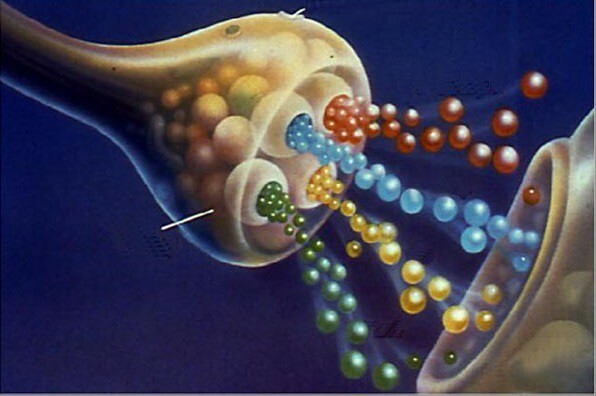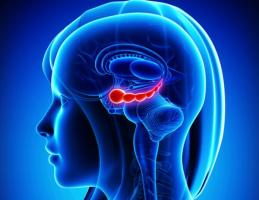Types of neurotransmitters: functions and classification
The neurotransmitters are chemicals created by the body that transmit signals (that is, information) from one neuron to the next through contact points called synapse.
When this occurs, the chemical is released by the vesicles of the presynaptic neuron, crosses the synaptic space, and acts by changing the action potential in the postsynaptic neuron.
There are different types of neurotransmitters, each with different functions. In fact, the study of this class of substances is essential to understand how the human mind works. In addition, there are different classification systems, intermediate concepts that allow us to see the affinities and differences between these substances: indolamines, catecholamines, etc.
In this article we will review some of the different classes of neurotransmitters, the most meaningful, taking into account the relationships they establish between them in the operation of the nervous system.
- Related article: "Types of neurons: characteristics and functions"

Main neurotransmitters and their functions
The list of known neurotransmitters has been growing since the 1980s, and currently there have been more than 60.
This is not surprising, considering the complexity and versatility of the human brain. All kinds of mental processes take place in it, from the management of emotions to planning and strategy creation, going through involuntary movements and the use of language.
All this variety of tasks it has many neurons behind it coordinating with each other To make the different parts of the brain work in a coordinated way, and for this it is necessary that they have a mode of communication capable of adapting to many situations.
The use of different types of neurotransmitters makes it possible to regulate in many different ways the way in which one or other groups of nerve cells are activated. For example, a certain occasion may require that serotonin levels go down and dopamine levels go up, and that will have a certain consequence on what happens in our mind. Thus, the existence of the great variety of neurotransmitters allows the nervous system to have a wide range of behaviors, which is necessary to adapt to a changing environment constantly.
In short, having more neurotransmitters involved in the functioning of the nervous system (and its corresponding receptors on nerve cells) means that there is more variety of possible interactions between groups of neurons. But, What are the most important types of neurotransmitters in the human body and what functions do they perform? The main neurochemicals are listed below.
1. Serotonin
This neurotransmitter is synthesized from tryptophan, an amino acid that is not manufactured by the body, so it must be provided through the diet. The serotonin (5-HT) it is commonly known as the hormone of happiness, because low levels of this substance are associated with depression and obsession. It belongs to the group of indolamines.
In addition to its relationship with mood, 5-HT performs different functions within the body, among which the following stand out: its role fundamental in digestion, the control of body temperature, its influence on sexual desire or its role in regulating the cycle sleep-wake.
Excess serotonin can cause a set of symptoms of varying severity, but in its fair measure, it is believed to help combat stress and anxiety. In addition, there are natural ways to enhance the power of serotonin over our central nervous system, such as moderate exercise.
- If you want to know more, you can visit our article: "Serotonin syndrome: causes, symptoms and treatment"
2. Dopamine
Dopamine is another of the best known neurotransmitters, because is involved in addictive behaviors and is the cause of pleasurable sensations. However, among its functions we also find the coordination of certain movements muscles, memory regulation, cognitive processes associated with learning and taking decisions
- To know more: "Dopamine: 7 essential functions of this neurotransmitter"
3. Endorphins
Have you noticed that after going for a run or practice physical exercise do you feel better, more animated and energetic? Well, this is mainly due to endorphins, a natural drug that is released by our body and that produces a sensation of pleasure and euphoria.
Some of its functions are: promote calm, improve mood, reduce pain, delay the aging process or enhance the functions of the immune system.
4. Adrenaline (epinephrine)
Adrenaline is a neurotransmitter that triggers survival mechanisms, as it is associated with situations in which we have to be alert and activated because it allows us to react in stressful situations.
In short, adrenaline fulfills both physiological functions (such as the regulation of blood pressure or rhythm respiratory and pupil dilation) as well as psychological (stay alert and be more sensitive to any stimulus).
- To delve into this chemical substance, you can read our post: "Adrenaline, the hormone that activates us"
5. Norepinephrine (norepinephrine)
Adrenaline is involved in different functions of the brain and is related to motivation, anger or sexual pleasure. Norepinephrine mismatch is associated with depression and anxiety.
- You may be interested in: The chemistry of love: a very powerful drug
6. Glutamate
Glutamate is the most important excitatory neurotransmitter in the central nervous system. It is especially important for memory and its recovery, and it is considered the main mediator of sensory, motor, cognitive and emotional information. In some way, it stimulates several essential mental processes.
Research affirms that this neurotransmitter is present in 80-90% of brain synapses. Excess glutamate is toxic to neurons and is associated with diseases such as epilepsy, stroke, or amyotrophic lateral disease.
- Related article: Glutamate (neurotransmitter): definition and functions
7. GABA
GABA (gamma-aminobutyric acid) acts as an inhibitory messenger, thereby slowing down the action of excitatory neurotransmitters. It is widely distributed in the neurons of the cortex, and contributes to motor control, vision, regulates anxiety, among other cortical functions.
On the other hand, this is one of the types of neurotransmitters that do not cross the blood brain barrier, for which it must be synthesized in the brain. Specifically, it is generated from glutamate.
- Learn more about this neurotransmitter clicking here.
8. Acetylcholine
As a curiosity, this is the first neurotransmitter to be discovered. This event occurred in 1921 and the discovery was made thanks to Otto Loewi, a German biologist who won the Nobel Prize in 1936. Acetylcholine widely distributed throughout the synapses of the central nervous system, but it is also found in the peripheral nervous system.
Some of the most prominent functions of this neurochemical are: participates in the stimulation of muscles, in the transition from sleep to wakefulness and in memory and association processes.
Classification of neurotransmitters
The types of neurotransmitters can be classified from these categories, each of which includes several substances:
1. Amines
They are neurotransmitters that derived from different amino acids like, for example, tryptophan. In this group are: norepinephrine, epinephrine, dopamine or serotonin.
2. Amino acids
Unlike the previous ones (which are derived from different amino acids), these are amino acids. For example: Glutamate, GABA, Aspartate, or Glycine.
3. Purinas
Recent research indicates that purines such as ATP or adenosine they also act as chemical messengers.
4. Gases
Nitric oxide it is the main neurotransmitter of this group.
5. Peptides
Peptides are widely distributed throughout the brain. For example: endorphins, dinorphins and takinins.
6. Esters
Within this group is acetylcholine.
Its operation
It should not be forgotten that, despite the fact that each of the types of neurotransmitters can be associated with certain functions in the nervous system (and, therefore, with certain effects to psychological level), they are not elements with intentions and a goal to follow, so their repercussions on us are purely circumstantial and depend on the context.
In other words, neurotransmitters have the effects they have because our body has evolved to make this exchange of substances something that helps us survive, by allowing the coordination of different cells and organs of the body.
Therefore, when we consume drugs that emulate the functioning of these neurotransmitters, they often have side effects that they can even be the opposite of the expected effect, if they interact abnormally with the substances that are already in our system highly strung. The balance that is maintained in the functioning of our brain is somewhat fragile, and neurotransmitters do not learn to adapt their influence on us to comply with what it is supposed to be "its function"; we should worry about that.
In addition, there are certain addictive substances that are capable of altering the medium and long-term functioning of nerve cells, by replacing some neurotransmitters at key points. Therefore, to treat addicted people, it is essential to intervene in behavior and also in brain function.
On the other hand, reducing the behavior of a human being to the existence of types of neurotransmitters is to fall into the error of an excessive reductionism, since the behavior does not arise spontaneously from the brain, but it appears from the interaction between the living being and the environment.
Bibliographic references:
- Carlson, N.R. (2005). Physiology of behavior. Madrid: Pearson Education.
- Lodish, H.; Berk, A.; Zipursky, S.L. (2000). Molecular Cell Biology: Section 21.4. Neurotransmitters, Synapses, and Impulse Transmission (4th ed.). New York: W. H. Freeman.
- Gómez, M. (2012). Psychobiology. CEDE Preparation Manual PIR. 12. CEDE: Madrid.
- Guyton-Hall (2001). Treaty of Medical Physiology, 10th ed., McGraw-Hill-Interamericana.
- Pérez, R. (2017). Pharmacological treatment of depression: current events and future directions. Rev. Fac. Med. (Mex.), 60 (5). Mexico City.
- Richard K. Ries; Gives life. Fiellin; Shannon C. Miller (2009). Principles of addiction medicine (4th ed.). Philadelphia: Wolters Kluwer / Lippincott Williams & Wilkins. pp. 709 - 710.
- Sugden, D., Davidson, K., Hough, K.A. and Teh, M.T. (2004). Melatonin, melatonin receptors and melanophores: a moving story. Pigment Cell Res. 17(5): 454-60.

